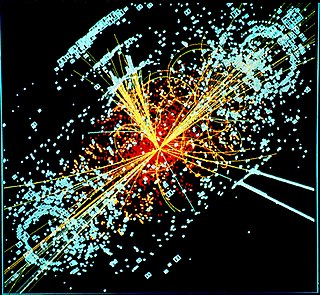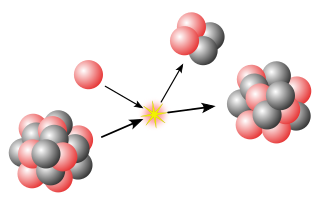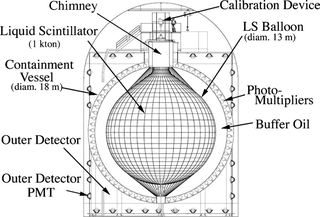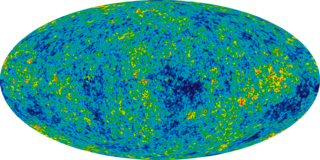Related Research Articles

In nuclear physics, beta decay (β-decay) is a type of radioactive decay in which an atomic nucleus emits a beta particle, transforming into an isobar of that nuclide. For example, beta decay of a neutron transforms it into a proton by the emission of an electron accompanied by an antineutrino; or, conversely a proton is converted into a neutron by the emission of a positron with a neutrino in what is called positron emission. Neither the beta particle nor its associated (anti-)neutrino exist within the nucleus prior to beta decay, but are created in the decay process. By this process, unstable atoms obtain a more stable ratio of protons to neutrons. The probability of a nuclide decaying due to beta and other forms of decay is determined by its nuclear binding energy. The binding energies of all existing nuclides form what is called the nuclear band or valley of stability. For either electron or positron emission to be energetically possible, the energy release or Q value must be positive.

A muon is an elementary particle similar to the electron, with an electric charge of −1 e and spin-1/2, but with a much greater mass. It is classified as a lepton. As with other leptons, the muon is not thought to be composed of any simpler particles.

A neutrino is an elementary particle that interacts via the weak interaction and gravity. The neutrino is so named because it is electrically neutral and because its rest mass is so small (-ino) that it was long thought to be zero. The rest mass of the neutrino is much smaller than that of the other known elementary particles. The weak force has a very short range, the gravitational interaction is extremely weak due to the very small mass of the neutrino, and neutrinos do not participate in the electromagnetic interaction or the strong interaction. Thus, neutrinos typically pass through normal matter unimpeded and undetected.

Neutrino oscillation is a quantum mechanical phenomenon in which a neutrino created with a specific lepton family number can later be measured to have a different lepton family number. The probability of measuring a particular flavor for a neutrino varies between three known states, as it propagates through space.

In nuclear physics, double beta decay is a type of radioactive decay in which two neutrons are simultaneously transformed into two protons, or vice versa, inside an atomic nucleus. As in single beta decay, this process allows the atom to move closer to the optimal ratio of protons and neutrons. As a result of this transformation, the nucleus emits two detectable beta particles, which are electrons or positrons.

Neutrinoless double beta decay (0νββ) is a commonly proposed and experimentally pursued theoretical radioactive decay process that would prove a Majorana nature of the neutrino particle. To this day, it has not been found.

The Kamioka Liquid Scintillator Antineutrino Detector (KamLAND) is an electron antineutrino detector at the Kamioka Observatory, an underground neutrino detection facility in Hida, Gifu, Japan. The device is situated in a drift mine shaft in the old KamiokaNDE cavity in the Japanese Alps. Although located in the Kamioka Observatory, which is part of the University of Tokyo, this project is conducted by a team at Tohoku University. The site is surrounded by 53 Japanese commercial nuclear reactors. Nuclear reactors produce electron antineutrinos () during the decay of radioactive fission products in the nuclear fuel. Like the intensity of light from a light bulb or a distant star, the isotropically-emitted flux decreases at 1/R2 per increasing distance R from the reactor. The device is sensitive up to an estimated 25% of antineutrinos from nuclear reactors that exceed the threshold energy of 1.8 megaelectronvolts (MeV) and thus produces a signal in the detector.
Sterile neutrinos are hypothetical particles that interact only via gravity and not via any of the other fundamental interactions of the Standard Model. The term sterile neutrino is used to distinguish them from the known, ordinary active neutrinos in the Standard Model, which carry an isospin charge of ±+1/ 2 and engage in the weak interaction. The term typically refers to neutrinos with right-handed chirality, which may be inserted into the Standard Model. Particles that possess the quantum numbers of sterile neutrinos and masses great enough such that they do not interfere with the current theory of Big Bang nucleosynthesis are often called neutral heavy leptons (NHLs) or heavy neutral leptons (HNLs).

The cosmic neutrino background is the universe's background particle radiation composed of neutrinos. They are sometimes known as relic neutrinos.

Main injector neutrino oscillation search (MINOS) was a particle physics experiment designed to study the phenomena of neutrino oscillations, first discovered by a Super-Kamiokande (Super-K) experiment in 1998. Neutrinos produced by the NuMI beamline at Fermilab near Chicago are observed at two detectors, one very close to where the beam is produced, and another much larger detector 735 km away in northern Minnesota.

KATRIN is a German acronym for an undertaking to measure the mass of the electron antineutrino with sub-eV precision by examining the spectrum of electrons emitted from the beta decay of tritium. The experiment is a recognized CERN experiment (RE14). The core of the apparatus is a 200-ton spectrometer.
T2K is a particle physics experiment studying the oscillations of the accelerator neutrinos. The experiment is conducted in Japan by the international cooperation of about 500 physicists and engineers with over 60 research institutions from several countries from Europe, Asia and North America and it is a recognized CERN experiment (RE13). T2K collected data within its first phase of operation from 2010 till 2021. The second phase of data taking is expected to start in 2023 and last until commencement of the successor of T2K – the Hyper-Kamiokande experiment in 2027.
The Enriched Xenon Observatory (EXO) is a particle physics experiment searching for neutrinoless double beta decay of xenon-136 at WIPP near Carlsbad, New Mexico, U.S.
The helium hydride ion, hydridohelium(1+) ion, or helonium is a cation (positively charged ion) with chemical formula HeH+. It consists of a helium atom bonded to a hydrogen atom, with one electron removed. It can also be viewed as protonated helium. It is the lightest heteronuclear ion, and is believed to be the first compound formed in the Universe after the Big Bang.

Main Injector Experiment for ν-A, or MINERνA, is a neutrino scattering experiment which uses the NuMI beamline at Fermilab. MINERνA seeks to measure low energy neutrino interactions both in support of neutrino oscillation experiments and also to study the strong dynamics of the nucleon and nucleus that affect these interactions.

Borexino is a deep underground particle physics experiment to study low energy (sub-MeV) solar neutrinos. The detector is the world's most radio-pure liquid scintillator calorimeter and is protected by 3,800 meters of water-equivalent depth. The scintillator is pseudocumene and PPO which is held in place by a thin nylon sphere. It is placed within a stainless steel sphere which holds the photomultiplier tubes (PMTs) used as signal detectors and is shielded by a water tank to protect it against external radiation. Outward pointing PMT's look for any outward facing light flashes to tag incoming cosmic muons that manage to penetrate the overburden of the mountain above. Neutrino energy can be determined through the number of photoelectrons measured in the PMT's. While the position can be determined by extrapolating the difference in arrival times of photons at PMT's throughout the chamber.
The Neutrino Ettore Majorana Observatory is an international collaboration of scientists searching for neutrinoless double beta decay (0νββ). The collaboration has been active since 1989. Observation of 0νββ would indicate neutrinos are Majorana particles and could be used to measure the neutrino mass. It is located in the Modane Underground Laboratory (LSM) in the Fréjus Road Tunnel. The experiment has had 3 detectors, NEMO-1, NEMO-2, NEMO-3 and is planning to construct a new detector SuperNEMO. The NEMO-1 and NEMO-2 prototype detectors were used until 1997. Latest experiment NEMO-3 was under design and construction from 1994 onwards, took data from January 2003 to January 2011 and the final data analysis was published in 2018. The NEMO-2 and NEMO-3 detectors produced measurements for double neutrino decays and limits for neutrinoless double-beta decay for a number of elements, such as molybdenum-100 and selenium-82. These double beta decay times are important contributions to understanding the nucleus and are needed inputs for neutrinoless decay studies, which constrain neutrino mass.

In nuclear and particle physics, a geoneutrino is a neutrino or antineutrino emitted during the decay of naturally-occurring radionuclides in the Earth. Neutrinos, the lightest of the known subatomic particles, lack measurable electromagnetic properties and interact only via the weak nuclear force when ignoring gravity. Matter is virtually transparent to neutrinos and consequently they travel, unimpeded, at near light speed through the Earth from their point of emission. Collectively, geoneutrinos carry integrated information about the abundances of their radioactive sources inside the Earth. A major objective of the emerging field of neutrino geophysics involves extracting geologically useful information from geoneutrino measurements. Analysts from the Borexino collaboration have been able to get to 53 events of neutrinos originating from the interior of the Earth.

The Cryogenic Underground Observatory for Rare Events (CUORE) – also cuore (Italian for 'heart'; ) – is a particle physics facility located underground at the Laboratori Nazionali del Gran Sasso in Assergi, Italy. CUORE was designed primarily as a search for neutrinoless double beta decay in 130Te, a process that has never been observed. It uses tellurium dioxide (TeO2) crystals as both the source of the decay and as bolometers to detect the resulting electrons. CUORE searches for the characteristic signal of neutrinoless double beta decay, a small peak in the observed energy spectrum around the known decay energy; for 130Te, this is Q = 2527.518 ± 0.013 keV. CUORE can also search for signals from dark matter candidates, such as axions and WIMPs.
The STEREO experiment investigated the possible oscillation of neutrinos from a nuclear reactor into light so-called sterile neutrinos. It was located at the Institut Laue–Langevin (ILL) in Grenoble, France. The experiment took data from November 2016 to November 2020. The final results of the experiment rejected the hypothesis of a light sterile neutrino.
References
- ↑ More specifically, the electron-weighted neutrino mass; see the page on Neutrinos - Flavor, mass, and their mixing for details.
- ↑ Kwon, Diana (2015-05-20). "Small teams, big dreams | symmetry magazine". www.symmetrymagazine.org. Retrieved 2024-11-18.
- ↑ "Циклотронное излучение открывает новые возможности для измерения массы нейтрино • Новости науки". «Элементы» (in Russian). Retrieved 2024-11-18.
- ↑ Overgaard, Elise (2023-01-24). "Ways to weigh a neutrino | symmetry magazine". www.symmetrymagazine.org. Retrieved 2024-11-18.
- ↑ Huber, Patrick (2015-04-20). "Cyclotron Radiation from One Electron". Physics. 8: 36. doi:10.1103/PhysRevLett.114.162501.
- ↑ "Neutrino Mass Experiment - About". www.project8.org. Retrieved 2024-11-18.
- ↑ Project 8 Collaboration; et al. (Project 8 Collaboration) (2022-03-14). "The Project 8 Neutrino Mass Experiment". arXiv: 2203.07349 [physics.ins-det].
{{cite arXiv}}: CS1 maint: numeric names: authors list (link) - ↑ Asner, D. M.; Bradley, R. F.; de Viveiros, L.; Doe, P. J.; Fernandes, J. L.; Fertl, M.; Finn, E. C.; Formaggio, J. A.; Furse, D.; Jones, A. M.; Kofron, J. N.; LaRoque, B. H.; Leber, M.; McBride, E. L.; Miller, M. L. (2015-04-20). "Single-Electron Detection and Spectroscopy via Relativistic Cyclotron Radiation". Physical Review Letters. 114 (16): 162501. arXiv: 1408.5362 . Bibcode:2015PhRvL.114p2501A. doi:10.1103/PhysRevLett.114.162501. ISSN 0031-9007. PMID 25955048.
- ↑ Bodine, L. I.; Parno, D. S.; Robertson, R. G. H. (27 March 2015). "Assessment of molecular effects on neutrino mass measurements from tritium β decay". Physical Review C. 91 (3): 035505. arXiv: 1502.03497 . Bibcode:2015PhRvC..91c5505B. doi:10.1103/PhysRevC.91.035505.
- ↑ Formaggio, Joseph A.; de Gouvêa, André Luiz C.; Robertson, R. G. Hamish (3 June 2021). "Direct measurements of neutrino mass". Physics Reports. 914: 1–54. arXiv: 2102.00594 . Bibcode:2021PhR...914....1F. doi:10.1016/j.physrep.2021.02.002.
- ↑ None, None (1 October 2023). "A New Era of Discovery: The 2023 Long Range Plan for Nuclear Science". doi:10.2172/2280968. OSTI 2280968.
{{cite journal}}: Cite journal requires|journal=(help)